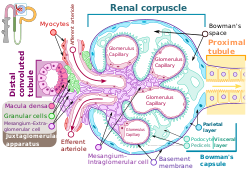This article needs additional citations for verification. (May 2015) |
| Juxtaglomerular apparatus | |
|---|---|
 A renal corpuscle, showing the juxtaglomerular apparatus with Juxtaglomerular cells (granular cells), Macula densa cells and, extraglomerular mesangium. | |
| Identifiers | |
| MeSH | D007606 |
| FMA | 83599 |
| Anatomical terminology | |
The juxtaglomerular apparatus (also known as the juxtaglomerular complex) is a structure in the kidney that regulates the function of each nephron, the functional units of the kidney. The juxtaglomerular apparatus is named because it is next to (juxta-[1]) the glomerulus.
The juxtaglomerular apparatus consists of three types of cells:
- the macula densa, in the distal straight tubule (thick ascending limb of the loop of Henle), after which the distal convoluted tubule begins [2] [3]
- juxtaglomerular cells, (also known as granular cells) which secrete renin
- extraglomerular mesangial cells
- ^ "Dictionary.com". Retrieved 11 June 2015.
- ^ Gonzalez-Vicente, Agustin; Saez, Fara; Monzon, Casandra M.; Asirwatham, Jessica; Garvin, Jeffrey L. (2019). "Thick Ascending Limb Sodium Transport in the Pathogenesis of Hypertension". Physiological Reviews. 99 (1): 235–309. doi:10.1152/physrev.00055.2017. PMC 6335098. PMID 30354966.
- ^ "Tubuloglomerular Feedback - an overview | ScienceDirect Topics".